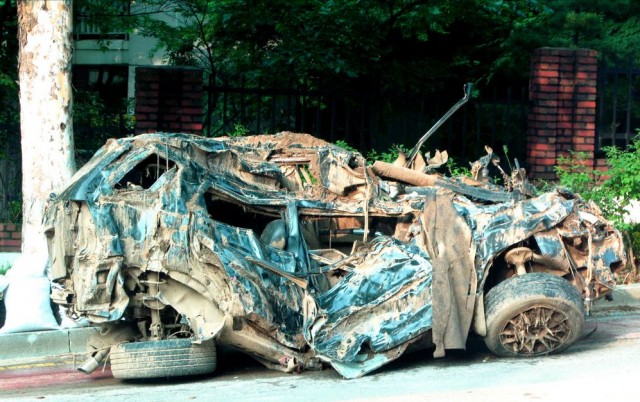13 July 2015
The 2011 Umyeonsan debris flows in South Korea
Posted by Dave Petley
The 2011 Umyeonsan debris flows in South Korea
On 27th July 2011 an intense rainfall event in Umyeonsan, in Seoul,the capital of South Korea, killed 16 people and caused widespread damage. In a paper just published in the Journal Landslides, Jeong et al (2015) have analysed these landslides in detail. They report that the rainstorm, which had a peak intensity of 112.5 mm, triggered 33 debris flows and 151 landslides. The debris flows caused most of the damage, some of which were caught on dramatic videos:
.
And
.
The study by Jeong et al (2015) is impressively detailed. I will highlight two aspects here. First, the density of landslides in the Umyeonsan area is remarkably high. This image from the paper shows the debris flow gullies (in blue) and the landslide initiation points (yellow circles):

Satellite image showing the 33 debris flow gullies (marked in blue) and 151 landslides (i.e., debris flow initiation points denoted by yellow circles) in the 20 watersheds (outlined by white lines) from Jeong et al. (2015)
.
Jeong et al. (2015) ascribe this high density of landslides to a combination of thick colluvium associated with a fault zone, the intense and prolonged rainfall, the steep slopes and the vegetation, which is characterised by low root depths (thus providing little additional strength).
The debris flows themselves are in many ways classic for this type of environment, and are in many ways similar to those observed in natural terrain in Hong Kong. The debris flows started as small failures in colluvium on the hillside, in many cases with multiple small slips occurring in the same catchment. These small failures underwent a rapid mobilisation process and entered the main channel. Jeong et al. (2015) suggest that thereafter the flows eroded and incorporated sediment within the channel, rapidly increasing in size. It is likely that the flows created and broke a series of small dams, possibly partially caused by channel blockage by trees and other woody debris, allowing the creation of large volume, rapid failures. Based on the videos, the authors estimate that one of the failures was traveling at about 28.6 m/sec when it struck the road. This debris flow killed three people; the effects of such a catastrophic debris flow are truly catastrophic:-
.
Reference
Jeong, S., Kim, Y., Lee, J. and Kim, J. 2015. The 27 July 2011 debris flows at Umyeonsan, Seoul, Korea. Landslides. http://dx.doi.org/10.1007/s10346-015-0595-0



 Dave Petley is the Vice-Chancellor of the University of Hull in the United Kingdom. His blog provides commentary and analysis of landslide events occurring worldwide, including the landslides themselves, latest research, and conferences and meetings.
Dave Petley is the Vice-Chancellor of the University of Hull in the United Kingdom. His blog provides commentary and analysis of landslide events occurring worldwide, including the landslides themselves, latest research, and conferences and meetings.